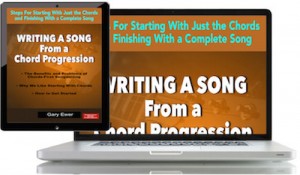If you have a reasonable understanding of how chords work, and already know which chords are likely to be useful in a given key, you’ve got an advantage over songwriters who must rely solely on improvising to create progressions.
If you want to have just a bit of chord theory to get you started, try reading this blog post from a few years back: “Chord Progression Basics for Songwriters“. It gives suggestions for other blog articles that can help.
 If you like starting your songwriting process with chords, you need to read “Writing a Song From a Chord Progression.” It will show you the advantages, but also the dangers, in creating a song where chords come first. It’s part of “The Essential Secrets of Songwriting” 10-eBook Bundle, or get it separately.
If you like starting your songwriting process with chords, you need to read “Writing a Song From a Chord Progression.” It will show you the advantages, but also the dangers, in creating a song where chords come first. It’s part of “The Essential Secrets of Songwriting” 10-eBook Bundle, or get it separately.
And I sincerely believe that the more you know about chords and chord theory, the better your progressions will become.
But for now, if improvising is the way you create most of your chord progressions — but you find the process is a slow one — it’s best to start as simply as possible, and let your ears be your guide. Here’s a set of steps that will help guide your improvisatory process. It has this advantage: with each step, you’ve got a chord progression (however short) that is usable:
- Start with two chords whose roots are a 4th or 5th apart. So you might try C-F, C-Fm, or C-G, or if you’d like to try something minor, try Am-Em, Am-E7, Am-Dm, Am-D… that sort of thing. Strum back and forth on those two chords, creating a rhythm that you like.
- Add a third chord, and place it in between the two from your first step. Just keep choosing until you’ve found something you like. If Am-Em was your choice in step 1, for example, you might try: Am-Dm-Em, or perhaps Am-F-E, or maybe Am-G-Em.
- Add a new chord and place it as the third chord in your progression. If you’ve settled on Am-F-E as your 3-chord progression, you might try Am-F-Dm-E. Or maybe Am-F-G-E. Or for something with a more interesting flavour, try Am-F-Bb/D-E.
Keep the process going if you’d like, and experiment with where in the progression you’d like to add your new chord.
The benefit to this way of working is that you always have something that works. So even if you’re struggling with adding a new chord, you’ve still got the progression from the previous step.
Of course, knowing a bit of chord theory is always helpful, so I’m suggesting this process not necessarily because it will automatically give you a quick solution to your chord progression woes, but because it relies completely on your ears.
So use this process to come up with something if you’ve always relied on experimentation to get your progressions working. But if you take your songwriting seriously, you want to improve on all aspects of songwriting. This includes chords.
In addition to that blog post I mentioned earlier, give this article a read… It will help you understand what’s most important about how chords work: The Circle of Fifths Progression: Making It Relevant for Songwriters.
 Written by Gary Ewer. Follow on Twitter.
Written by Gary Ewer. Follow on Twitter.
 “The Essential Secrets of Songwriting” eBook Bundle package looks at songwriting from every angle, and has been used by thousands of songwriters. How to use chords, write melodies, and craft winning lyrics. Take advantage of the Deluxe Bundle DISCOUNT.
“The Essential Secrets of Songwriting” eBook Bundle package looks at songwriting from every angle, and has been used by thousands of songwriters. How to use chords, write melodies, and craft winning lyrics. Take advantage of the Deluxe Bundle DISCOUNT.










